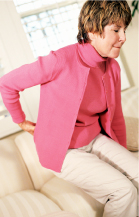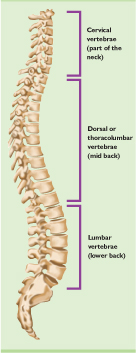Why does my back ache?
It's estimated that at least 70 percent of people suffer from backaches, either chronic or sporadic back pain. Backache may be caused by a number of factors, which is why it is important that your doctor diagnose your pains for proper treatment.

+ In many cases back pains are brought on by bad posture, tension or muscle spasms. These symptoms need medical attention and aren't treated by reducing the time you commute, sit or work. They can become chronic problems. In other cases, backaches are caused by physical ailments. The most common ailments causing backaches diagnosed by doctors are the following:
- ∎ Degenerative disk. The disks in the spine are like small sponges that rest between each vertebrae and act as shock absorbers. As we age, they lose their “shockabsorbing” characteristics. Degenerative disk disorder is a result of the normal aging process. But it may also occur as a result of a herity, trauma or direct injury to the disk. As the vertebrae shift, pinching and irritation of the nerve root can happen and muscles begin to tighten and spasm.
- ∎ Herniated disk. A disk in the lumbar area becomes herniated when the gel within the disk balloons outward pressing on the nerves around the backbone, producing intense pain.
- ∎ Referred pain. Any structure in the lumbar spine can refer pain to other areas of the body. This occurs because the affected part of the spine shares the same nerve supply as the area that the pain is referred to. It's possible that you have a back ailment and pain appears in your arms or shoulders.
- ∎ Osteoporosis. Progressive thinning of bone structure with loss of bone calcium, leading to an increased risk of fractures. The spine becomes more compressed, causing posture changes and pain.
-
∎
Kyphosis (kyphoscoliosis).
Kyphosis refers to a hunching, or forward curvature in the upper part
of the spine.
When the degree of kyphosis is above normal then some form of treatment may be required. With aging there is a gradual, and natural, increase in the thoracic kyphosis that gives an appearance of hunching forward more with advancing age. - ∎ Scoliosis. May result from a birth condition developed later in life, most. It usually develops in the upper or in the thoracolumbar area of the spine. The curvature of the spine from scoliosis may develop as a single curve or as an “s”.
- ∎ Lordosis. Refers to the inward curve of the lumbar spine (just above the buttocks). A small degree of both kyphotic and lordotic curvature is normal, but can get worse with bad posture or excess weight. Lordosis can lead to lumbago or an increased wearing down of the vertebrae.
STRUCTURE OF THE SPINAL COLUMN

As with any other ailment, as soon as symptoms appear one should consult a medical practitioner, because for each case there's a treatment that should be followed under the doctor's supervision.

Comment about this article, ask questions, or add new information about this topic: